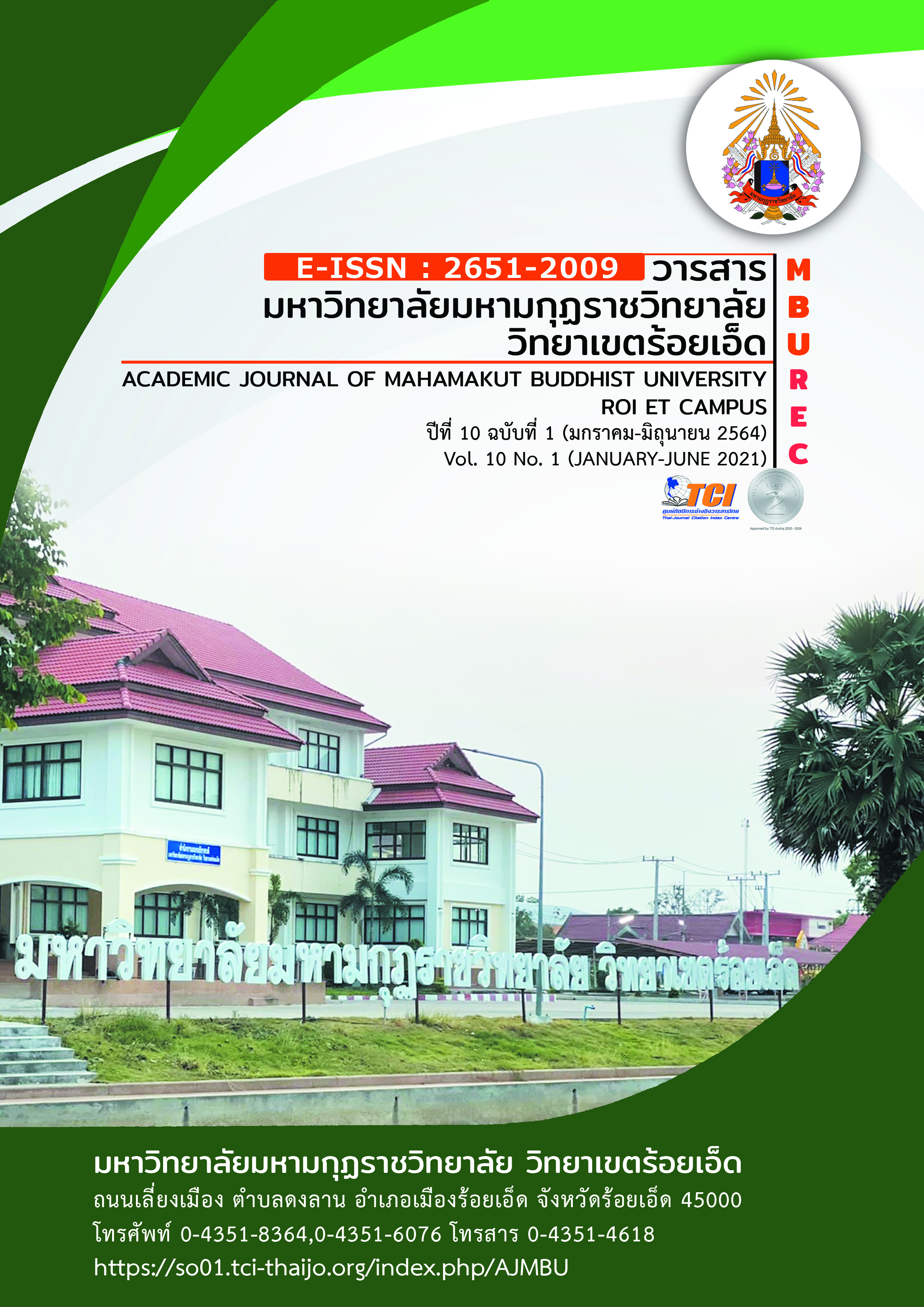Creative Leadership of Educational Institution Administrators Affecting the Effectiveness of Educational Institutions under Maha Sarakham Vocational Education
Main Article Content
Abstract
The objectives of the research article were 1) to study creative leadership of educational institution administrators and the effectiveness of educational institutions, 2) to study the relationship between creative leadership of educational institution administrators and the effectiveness of educational institutions 3) to study predictable variables for creative leadership of educational institution administrators affecting the effectiveness of educational institutions. The sample group were institution administrators and teachers total number of 214 people. The instrument used in the research was a 5-level rating scale questionnaire. The statistics used in this research comprised frequency, percentage, mean, standard deviation, Pearson's product moment correlation coefficient and Stepwise multiple regression coefficient.
The research results were found that: 1. Creative leadership of educational institution administrators in overall and each aspect, was rated at a high level. The aspect with the highest mean was vision, followed by consideration of one’s individuality, the aspect with the lowest mean was creativity. The effectiveness of educational institutions in overall and each aspect, was rated at a high level. The aspect with the highest mean was ability in solving problems in educational institutions, followed by the ability in modifying and developing educational institutions. The aspect with the lowest mean was the ability in developing students having a positive attitude. 2. The relationship between creative leadership of educational institution administrators and the effectiveness of educational institutions was found that correlation coefficient between creative leadership and the effectiveness of educational institutions in all aspects was in a positive way. When considering correlation coefficients in each aspect, it was found that flexibility and adaptation and creativity were at a high level, while the consideration of one’s individuality, team work and vision were rated at a moderate level with statistical significance at .01 level. 3. Regarding the creative leadership of educational institution administrators affecting the effectiveness of educational institutions, the results of multiple regression analysis showed that there were 4 variables had statistically significant relationships at .01 level with teamwork, followed by flexibility and adaptability, vision and creativity, and a multiple correlation coefficient was at .896 with statistical significance at 01 level, the prediction coefficient was at 80.30% (R2 = 0.803)
Article Details
References
กันยากร จินสีดา, นิยดา เปี่ยมพืชนะ. (2561). ภาวะผู้นำเชิงสร้างสรรค์ของผู้บริหารสถานศึกษาที่ส่งผลต่อประสิทธิผลของสถานศึกษา สังกัดองค์การบริหารส่วนจังหวัดขอนแก่น. วารสารมหาวิทยาลัยมหามกุฏราชวิทยาลัย วิทยาเขตร้อยเอ็ด. 8(2). 229-241.
เฉลา ระโหฐาน. (2553). การศึกษาความสัมพันธ์ระหว่างภาวะผู้นำการเปลี่ยนแปลงของผู้บริหารและประสิทธิผลในการบริหารงานของสถานศึกษาขั้นพื้นฐาน ในสังกัดสำนักงานเขตพื้นที่การศึกษาชลบุรี เขต 2. วิทยานิพนธ์ครุศาสตรมหาบัณฑิต สาขาวิชาบริหารการศึกษา. มหาวิทยาลัยราชภัฏราชนครินทร์.
ชิษณุพงศ์ ถ้ำกลาง. (2559). ความสัมพันธ์คาโนนิคอลระหว่างความฉลาดทางอารมณ์และภาวะผู้นำเชิงสร้างสรรค์ ของผู้บริหารสถานศึกษา สังกัดสำนักงานเขตพื้นที่การศึกษา ประถมศึกษานครราชสีมา เขต 6. วิทยานิพนธ์ครุศาสตรมหาบัณฑิต สาขาวิชาการบริหารการศึกษา. มหาวิทยาลัยราชภัฏนครราชสีมา.
นัยนา ชนาฤทธิ์. (2556). ภาวะผู้นำเชิงสร้างสรรค์ของผู้บริหารสถานศึกษา สังกัดสำนักงานเขตพื้นที่การศึกษาประถมศึกษาขอนแก่น เขต 5. วิทยานิพนธ์ศึกษาศาสตรมหาบัณฑิต สาขาวิชาการบริหารการศึกษา. บัณฑิตวิทยาลัย : มหาวิทยาลัยมหาสารคาม.
วินา สุทธิโพธิ์. (2561). ภาวะผู้นำเชิงสร้างสรรค์ของผู้บริหารสถานศึกษาในโรงเรียน สังกัดสำนักงานเขตพื้นที่การศึกษาประถมศึกษาเลยเขต 2. วารสารวิทยาลัยสงฆ์นครลำปาง. 7(2). 99-114.
สุภาพ ฤทธิ์บำรุง. (2556). ภาวะผู้นาเชิงสร้างสรรค์ของผู้บริหารสถานศึกษาที่ส่งผลต่อความมีประสิทธิผลของโรงเรียน สังกัดสำนักงานเขตพื้นที่การศึกษามัธยมศึกษา เขต 30. วิทยานิพนธ์ศึกษาศาสตรมหาบัณฑิต สาขาวิชาการบริหารการศึกษา. มหาวิทยาลัยขอนแก่น.
อารีรัตน์ เพ็งสีแสง. (2558). ภาวะผู้นำเชิงสร้างสรรค์ของผู้บริหารสถานศึกษาตามการรับรู้ของครูที่ส่งผลต่อความเป็นครูมืออาชีพ ในโรงเรียน สังกัดองค์การบริหารส่วนจังหวัดขอนแก่น. วารสารศึกษาศาสตร์ มหาวิทยาลัยขอนแก่น. 38(4). 101-109.
อุดม พินธุรักษ์. (2553). ความสัมพันธ์ระหว่างภาวะผู้นำการเปลี่ยนแปลงของผู้บริหารสถานศึกษากับประสิทธิผลการบริหารงานบุคคลโรงเรียนประถมศึกษาสังกัดสำนักงานเขตพื้นที่การศึกษาอุดรธานี. วิทยานิพนธ์การบริหารการศึกษา. มหาวิทยาลัยราชภัฏอุดรธานี.
Adair, J. (2007). Leadership for Innovation: How to Organize Team Creativity and Harvest. Ideas : Kogan Page.
Ash, R.C &Persall J.M. (2007). The Principle as Chief Learning Officer. National Association of Secondary School Principles. 84(616). 15-22.
Dorothy, A. S. (2001). Spiritual intelligence: Developing higher consciousness. Creative Education Foundation.
Keamy. (2016). Creative leadership It’s just the norm. School Leadership & Management. Retrieved 14 October 2020. From https://www.tandfonline.com/doi/full/10.1080/ 13632434.2016.1196173

